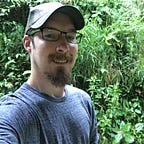Dendrology Shorts: Retrophyllum minus
Obligate Inhabitant of Aquatic Environments
Retrophyllum minus is an unusual species of tree in the Podocarpaceae family, a family endemic to the Southern Hemisphere. It occurs solely on the island of Grande Terre in New Caledonia, a French territory, 750 miles east of Australia in the Pacific Ocean. This island is a hotbed of conifer diversity, and New Caledonia’s gymnosperms derive from ancestral species isolated in the region when it broke away from Gondwana many tens of millions of years ago. Two Retrophyllum species live in New Caledonia. The etymology of the term retrophyllum comes from Latin and Greek words, respectively, meaning reversed leaf, and refers to the distinctive phyllotaxis in which the adaxial leaf surface is directed upwards on one side of the shoot while on the other the abaxial surface is directed upwards.
R. minus is a dwarf tree, growing up to 9 and a half feet tall. It grows in a very limited distribution within the Plaine des Lacs and the central drainage of the Yaté River. It is a relatively limited species, with an estimated 2,500 total individuals, and 250 or less at any one location. The total area in which it occurs is only 98.45 miles square. Within that area only about 15.4 square miles are actually inhabited by members of Retrophyllum minus.
This species is a rheophyte, which means it grows in running water and is an obligate inhabitant of aquatic environments such as streams. It is the only known conifer that is a rheophyte. Its seeds are light and float, allowing them to spread easily through the riverine habitat in which it lives. It survives in a limited habitat, from sea level to around 787 feet in elevation, in New Caledonia’s lowlands. It is completely limited to living in lotic ecosystems.
It has ovate-lanceolate needles, and has the typical phyllotaxis of Retrophyllum species. Retrophyllum minus are dioecious with male pollen cones and female seed cones on separate individual trees. Its male pollen cones are clustered or solitary at the end of shoots. Female seed cones are terminal with scale leaves and a solitary seed. The seeds have a crest and are covered by a fleshy epimatium, and are white or green, sometimes glaucous, when mature.
It has spongy bark in thick layers. Trunks are wider at the base, and the branches are stout. The crown is irregular, either spreading or ascending. It is unique in form, and due to its unique ecology easily identifiable in its native habitat. However, that unique ecology lends it to being easily harmed by environmental pollutants within the waters in which it grows.
Retrophyllum minus was once more widespread in southern New Caledonia. However, there has been a substantial decrease in population due to development of dams, wildfires, and the mining activities. Due to these ongoing threats a continuing decline in mature individuals is projected and it is listed on the IUCN Red List as Endangered. Those environmental pollutants that most often disturb R. minus come from mining upstream of their range.
New Caledonia’s native People are the Kanak, and their traditional way of life as well as the ecosystem of Grande Terre has been heavily damaged by nickel mining operations. These mining operations, led by such multinational corporations as French Eramet and Canadian run International Nickel Co (INCO), degrade the environment. The hydrometallurgical processes used in nickel mining create numerous pollutants that are detrimental to the waterways of Grande Terre, and strip mining allows for intense runoff of soils and chemicals. In 2009, New Caledonia was the fifth largest producer and exporter of nickel worldwide, extracting 107 thousand tons of the ore. Its economic importance to the world nickel industry means it is unlikely that positive changes will be made to combat the environmental degradation that has been damaging the native habitat of Retrophyllum minus.
Sources:
Ali, S.H., and Grewal, A.S. (2004) New Approaches to Mining in New Caledonia. Cultural Survival Quarterly Magazine.
Farjon, A., & Filer, D. (2013). An Atlas of the World’s Conifers: An Analysis of their Distribution, Biogeography, Diversity and Conservation Status. Leiden, The Netherlands: Koninklijke Brill NV.
Farjon, A. (2008). A Natural History of Conifers. Portland, OR: Timber Press.
Jaffré, T., Bouchet, P. & Veillon, J.-M. (1998). Threatened plants of New Caledonia: Is the system of protected areas adequate? Biodiversity & Conservation. 7(1): 36.
Jaffré, T., Munzinger, J. & Lowry, P. P. (2010). Threats to the conifer species found on New Caledonia’s ultramafic massifs and proposals for urgently needed measures to improve their protection. Biodiversity & Conservation: 19(5):1485–1502.
Herbert, J., Hollingsworth, P. M., Gardner, M F., Mill, R. R. & Thomas, P. (2002). Conservation genetics and phylogenetics of New Caledonian Retrophyllum (Podocarpaceae) species. New Zealand Journal of Botany: 40: 175–188.
Thomas, P. (2010). Retrophyllum minus. IUCN Red List of Threatened Species 2017–2. www.iucnredlist.org. Downloaded on 09 November 2017.
U.S. Geologic Survey (2010). Nickel. Mineral Commodity Summaries. United States Department of the Interior.
